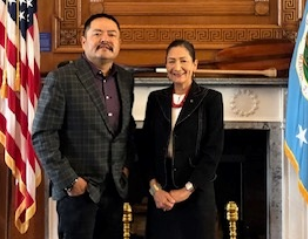
- Details
- By Levi Rickert
The U.S. Department of Interior announced on Friday that it will work with the San Carlos Apache Tribe to develop a plan to address electric power outages caused by repeated transmission line failures that have caused extreme hardship on the Reservation.
San Carlos Apache Tribe Councilman Eugene “David” Nozie met with Interior Secretary Deb Haaland on Sept. 9 in Washington to discuss the San Carlos Irrigation Project’s (SCIP) failure to provide reliable electricity for the reservation.
“Secretary Haaland said the department would form a working group with the Tribe as soon as possible to determine the best options to alleviate the power outages caused by repeated transmission line failures,” Councilman Nozie said. “We are grateful Secretary Haaland is committed to finding a solution to this serious problem that the threatens the health and welfare of Reservation residents, businesses and essential services.”
Last month, the SCIP main transmission line into the Reservation failed during a monsoon storm, leaving communities without power for 21 hours in the sweltering summer heat. The outage was just the latest in a long history of power failures.
“Power outages are all too frequent, some lasting for hours and some lasting days, paralyzing the Tribe’s essential facilities, cellular communications, government services, and water delivery,” said San Carlos Apache Tribe Chairman Terry Rambler. “We look forward to working with Secretary Haaland to find a permanent solution to this chronic problem.”
The SCIP was established in 1924 by the department’s Bureau of Indian Affairs to provide irrigation water and pumping to private landowners and electricity to residents on and off the Reservation.
The SCIP has 1,894 residential and 355 commercial Reservation customers. The Tribe has repeatedly requested federal authorities to replace the transmission line and construct a new access route along U.S. Highway 70.
More Stories Like This
Native News Weekly (August 25, 2024): D.C. BriefsUS Presidents in Their Own Words Concerning American Indians
Indigenous Actor Elaine Miles Reports Detention by Alleged ICE Agents
Happy Thanksgiving from Native News Online
Coming Up on Native Bidaské: Behind the Animation: Joey Clift Talks “Pow” and Native Storytelling
Help us tell the stories that could save Native languages and food traditions
At a critical moment for Indian Country, Native News Online is embarking on our most ambitious reporting project yet: "Cultivating Culture," a three-year investigation into two forces shaping Native community survival—food sovereignty and language revitalization.
The devastating impact of COVID-19 accelerated the loss of Native elders and with them, irreplaceable cultural knowledge. Yet across tribal communities, innovative leaders are fighting back, reclaiming traditional food systems and breathing new life into Native languages. These aren't just cultural preservation efforts—they're powerful pathways to community health, healing, and resilience.
Our dedicated reporting team will spend three years documenting these stories through on-the-ground reporting in 18 tribal communities, producing over 200 in-depth stories, 18 podcast episodes, and multimedia content that amplifies Indigenous voices. We'll show policymakers, funders, and allies how cultural restoration directly impacts physical and mental wellness while celebrating successful models of sovereignty and self-determination.
This isn't corporate media parachuting into Indian Country for a quick story. This is sustained, relationship-based journalism by Native reporters who understand these communities. It's "Warrior Journalism"—fearless reporting that serves the 5.5 million readers who depend on us for news that mainstream media often ignores.
We need your help right now. While we've secured partial funding, we're still $450,000 short of our three-year budget. Our immediate goal is $25,000 this month to keep this critical work moving forward—funding reporter salaries, travel to remote communities, photography, and the deep reporting these stories deserve.
Every dollar directly supports Indigenous journalists telling Indigenous stories. Whether it's $5 or $50, your contribution ensures these vital narratives of resilience, innovation, and hope don't disappear into silence.
 The stakes couldn't be higher. Native languages are being lost at an alarming rate. Food insecurity plagues many tribal communities. But solutions are emerging, and these stories need to be told.
The stakes couldn't be higher. Native languages are being lost at an alarming rate. Food insecurity plagues many tribal communities. But solutions are emerging, and these stories need to be told.
Support independent Native journalism. Fund the stories that matter.
Levi Rickert (Potawatomi), Editor & Publisher

